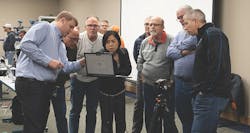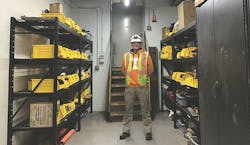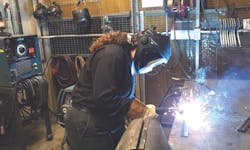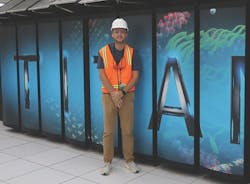Taking the right steps to asset management success and profit
When Dr. Klaus Blache accompanies you on a walk through your plant, prepare for your life to change. There is a John Muir quote: “In every walk with nature, one receives far more than he seeks.” Among the humming machines, echoes of steps on concrete, the twitchy robots, focused workers, you will discover your plant from a different perspective.
“We go on a walk. The walks on the plant floor are where the A-ha! moments happen,” says Dr. Blache, director of the Reliability & Maintainability Center (RMC) and research professor at the College of Engineering of the University of Tennessee in Knoxville. “This is where teams recognize, analyze, and solve problems.”
“I live for those light bulb moments,” says Jeff Shiver, managing principal at People and Processes, a training partner of the RMC, “where teams learn how to do things differently and stop what I would call ‘maintenance insanity,’ doing the same thing and expecting different results.”
“Walking the floor, teams start to see the macro picture of how all the pieces of maintenance, of reliability, come together for better asset management,” says Shon Isenhour, trainer at Eruditio, another key partner with the University of Tennessee.
- Read "Winds of digital change: How Chicago manufacturers are evolving and embracing new technologies"
As an engineer, tradesperson, technician, or corporate leader, you will learn best practices and the macro picture when attaining the Reliability and Maintainability Implementation Certification (RMIC). This premier national certification is part of the Tickle College of Engineering Guided Professional Development Program at the University of Tennessee. The training will also be useful to pursue the Certified Maintenance and Reliability Professional (CMRP) or Certified Maintenance and Reliability Technician (CMRT) designation offered through the Society for Maintenance and Reliability Professionals (SMRP).
The RMIC program consists of six adult education courses that include the R&M Boot Camp Course and three courses from multiple training partners. The final step to complete the certification is a mentored three- to six-month implementation project that delivers measurable results in a student’s workplace. Within the project, the student will be coached by Blache or partners, just as they have coached hundreds of manufacturing clients.
The University of Tennessee also offers both undergrad and graduate programs in reliability, a unique minor in maintainability, and many professional courses and events throughout the year. Courses are typically both onsite and virtual, but currently, all courses are virtual.
Common problems in reliability and maintenance
What are the common problems in reliability and maintainability found in these ambles through plants? According to Blache, who has worked with more than 1,000 manufacturing facilities throughout his career, the top three problems are (1) a lack of consistent leadership; (2) too much reactive maintenance; and (3) a lack of focus on organizational health compared to performance and operations.
Blache emphasizes that a complete reliability journey should be enterprise wide. Asset management, reliability, and maintenance are important to everybody in the plant. Let’s say, procurement buys cheaper, low-quality bearings. On paper, it looks like they are saving money, but the reality is more breakdowns and downtime. The engineer is frustrated and spends hours in overtime.
“Sometimes tribal knowledge moves us to ask the wrong questions. We develop hard construct routines,” says Ian McKinnon, principal of another training partner, Reliability Solutions. “For example, I would say the wrong question is: What is the appropriate value range of bolt torque? The first question to ask is: What is the lubricant being used on the threads?”
“There is practical problem-solving in engaged small teams,” Blache says. “For example, we say to Joe, ‘Did you know when you do X on the first shift, it requires Bob to do Y on the second shift?’ Then at some point, we get the two to have a conversation.”
The key move from the start is for corporate leadership to be totally engaged with the proposed solutions. In addition, the asset and reliability managers must communicate the benefits of a new system – whether it be a better lubrication process, a way to reduce downtime or decrease life cycle costs – all with upper management, finance, and the CEO onboard. In addition, asset and reliability managers must demonstrate the net present value and the annual value of the improvements. In other words, make it clear there is money to be made.
“There needs to be a shift in thinking, where maintenance and reliability are components of the profit center,” explains Tom Moriarty, author of The Productive Leadership System: Maximizing Organizational Reliability and president of Alidade Mer, Inc. “These are necessary functions and costs. Unfortunately, business schools still label them as liabilities.”
With Blache’s experience at the University of Tennessee consulting with several hundred companies on asset management initiatives and improvements, he can show a return on investment of about 5:1 to more than 100:1, with the average being 15:1 to 20:1. Even though Blache and his partners are restricted from using client names, he offered examples of savings from specific projects: $3.5 million in labor savings after a 40% reduction in planning hours; $400,000 savings per project per year after implementing a precision maintenance system; and a 15% increase in throughput after setting up predictive technology applications with a client.
Shiver added an example where they guided a chemical company with planning and scheduling. “The changes eliminated downtime and improved their process,” Shiver says. The change returned $1.8 million to the maintenance budget and in two years, gave $20 million back to their plant capacity and reduced storeroom inventory by $10 million.
These benefits could not happen without training and certification, as well as ongoing coaching and mentoring. In addition, certified individuals become subject matter experts in the companies and can look for greater opportunities in their current firm or elsewhere. “More and more companies rely on this training for peak performance,” says Gary Weiss, executive vice president and general manager for Vector Solutions, another key RMC partner.
“We see a high promotion rate after certification,” Isenhour says. “Their employee’s knowledge is validated, and their engagement improves.”
Overall, Blache and partners concur that the best actions to successful asset management are built on key foundational and hierarchical elements.
Starts with leadership: Building the vision
Once leadership is committed, the next step is strategic and begins with an assessment to discover the gaps or potential fault lines. Blache and company agree that you do not simply look for failures, you discover the potential for failures. This includes a critical analysis of the asset library. From there, they can create a reliability action plan with customized training for the clients.
“This is a framework, a road map, not a cookie-cutter approach,” Shiver says. “It is important to paint a vision because a plant’s team must understand what they are targeting.”
“We need to nurture the skills to better use precision and predictive maintenance technology,” Blache says. “From there we need to add the next level, prescriptive technology that uses what is learned and prescribes changes in the behavior. The technology changes as more data come in, using vast data for affordable solutions.”
Next is a focus on tactics that come with a root cause analysis of each problem. From there you can select a system for your reliability-centered maintenance.
Then, you get to what is the “hardest part,” according to Moriarty. “A core management process to sustain the change, follow the plan, and the new system.” It comes back to consistent leadership as well as organizational health. “The new system can be one CEO away from being wiped out,” Moriarty says. “The system needs good traction.”
“How do we get the plant floor to do better and keep that momentum? We create a culture of problem solvers,” Blache says. “We mentor and coach the plant floor to get there.”
“We work to prevent the failures in asset management, where there is also the human cost, the toll on people’s daily lives,” Shiver says. “On one project, I interviewed a technician who worked 80 hours a week, 16-hour days when the plant was not running well. Over his 35 years at this plant, he had missed recitals, games, and other important events and felt like he may need to get a divorce.”
RMC helps people and companies find those problems that cost money, time, and stress.
RMC will soon be opening a mock factory in Knoxville to teach plant floor skills, conduct mini assessments, and offer many more classes. They will also focus on the process and principles of leadership so “they have a complete understanding of reliability and maintainability, the bigger picture,” Blache says. “In training and consulting, I like to see deliverables in one year.” So yes, in a year, your plant will profit and so will your life.
Supporting note on career development and education
Companies and individuals can also find curriculum complementary to RMC within the continuing technical education in their state’s manufacturing organizations; local manufacturing extension programs through the Department of Commerce; programs and associate degrees in manufacturing at their local community colleges and universities as well as vocational-technical schools.
For companies and individuals in manufacturing that need financial support for their education and training, there are grants in reliability and maintenance management as well as in the trades. Community colleges can help with training plans, uncover grant resources, and help create proposals. The county or regional economic development council can typically point the way to grant money, such as Perkins federal grants (to enroll in career and technical education programs); Incumbent Worker Training (IWT) grants up to $8,000 for training per individual and 50% cost share with employer/employee; grants for veterans; and others.
Download a presentation on “Finding Federal Grants: Advancing Your Work in CTE.”
Deanna Nord, owner of Nord Strategy Group, is a writer, public speaker, and creative strategist. Contact her at [email protected].




